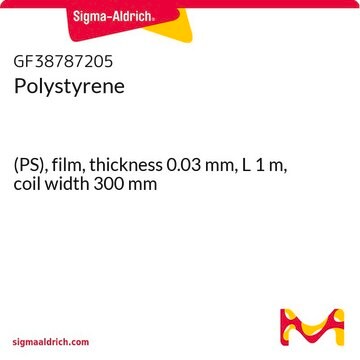Products may be shipped at a different temperature than the recommended long-term storage temperature. If the product quality is sensitive to short-term exposure to conditions other than the recommended long-term storage, it will be shipped on wet or dry-ice. If the product quality is NOT affected by short-term exposure to conditions other than the recommended long-term storage, it will be shipped at ambient temperature. As shipping routes are configured for minimum transit times, shipping at ambient temperature helps control shipping costs for our customers. For more information, please refer to the Storage and Transport Conditions document: https://www.sigmaaldrich.com/deepweb/assets/sigmaaldrich/marketing/global/documents/316/622/storage-transport-conditions-mk.pdf
Kluczowe dokumenty
331651
Polystyrene
average Mw 35,000
Synonim(y):
PS
About This Item
Polecane produkty
Formularz
beads or pellets
Poziom jakości
masa cząsteczkowa
average Mw 35,000
temp. przejścia
softening point (ASTM E 28) 123-128 °C
gęstość
1.06 g/mL at 25 °C
InChI
1S/C8H8/c1-2-8-6-4-3-5-7-8/h2-7H,1H2
Klucz InChI
PPBRXRYQALVLMV-UHFFFAOYSA-N
Szukasz podobnych produktów? Odwiedź Przewodnik dotyczący porównywania produktów
Opis ogólny
Zastosowanie
It can be used to stabilize the perovskite component by forming PS-capped perovskite grains. This PS coverage can suppress the organic component evaporation, and water corrosion and promotes crystal self-healing of perovskite films.
Due to its optical clarity, low production cost, and ease ofmanufacture, it is widely used as a fundamental substrate for in vitrocell culture.
Cechy i korzyści
- Thermal efficiency
- Durability
- Moisture resistance
Postać fizyczna
Kod klasy składowania
11 - Combustible Solids
Klasa zagrożenia wodnego (WGK)
WGK 3
Temperatura zapłonu (°F)
Not applicable
Temperatura zapłonu (°C)
Not applicable
Środki ochrony indywidualnej
Eyeshields, Gloves, type N95 (US)
Wybierz jedną z najnowszych wersji:
Masz już ten produkt?
Dokumenty związane z niedawno zakupionymi produktami zostały zamieszczone w Bibliotece dokumentów.
Klienci oglądali również te produkty
-
How is shipping temperature determined? And how is it related to the product storage temperature?
1 answer-
Helpful?
-
-
How can I determine the shelf life / expiration / retest date of this product?
1 answer-
If this product has an expiration or retest date, it will be shown on the Certificate of Analysis (COA, CofA). If there is no retest or expiration date listed on the product's COA, we do not have suitable stability data to determine a shelf life. For these products, the only date on the COA will be the release date; a retest, expiration, or use-by-date will not be displayed.
For all products, we recommend handling per defined conditions as printed in our product literature and website product descriptions. We recommend that products should be routinely inspected by customers to ensure they perform as expected.
For products without retest or expiration dates, our standard warranty of 1 year from the date of shipment is applicable.
For more information, please refer to the Product Dating Information document: https://www.sigmaaldrich.com/deepweb/assets/sigmaaldrich/marketing/global/documents/449/386/product-dating-information-mk.pdfHelpful?
-
-
What is the number molecular weight of this polystyrene? Do you have a GPC cromatogram of this polystyrene?
1 answer-
This product has an approximate molecular weight of 35,000. In regards to the GPC Chromatogram, please navigate to the link https://www.sigmaaldrich.com/techservice, click on "Product Technical Inquiries" under the Products Section with all the required information so that a member of the Technical Service team can reach out to assist further. Thank you.
Helpful?
-
Active Filters
Nasz zespół naukowców ma doświadczenie we wszystkich obszarach badań, w tym w naukach przyrodniczych, materiałoznawstwie, syntezie chemicznej, chromatografii, analityce i wielu innych dziedzinach.
Skontaktuj się z zespołem ds. pomocy technicznej


